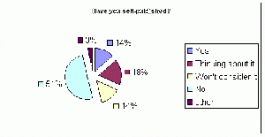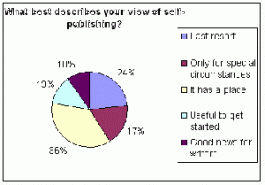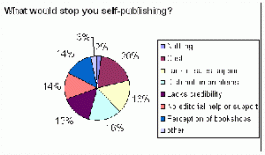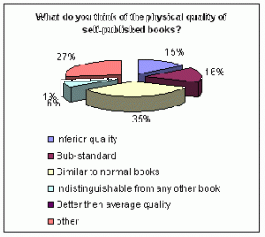Self publishing | Results
Magazine
The survey we conducted during the last quarter of 2005 looked at the future of self-publishing and attitudes towards it. There was a mix of quantitative and qualitative questions. The quantitative results have a semblance of statistical certainty but the opinions and essays provided by you give an informative and intimate view of how writers see self-publishing.
Summary
- One third of the respondents had either used self-publishing or were thinking about it.
- Two thirds can see a place for self-publishing.
- 14% would never consider self-publishing
- Lack of marketing support and poor perception of self-publishing mattered, but cost was the most important reason given for not publishing oneself.
- One third of the respondents think that self-published titles are inferior in production terms, but a similar proportion reckoned the finished products are indistinguishable from other books.
Survey Results
 |
Those responding to the survey know what they are talking about. Three-quarters had published at least one book. One third of the respondents had either used self-publishing or were thinking about it. |
| The strongest opposition to self-publishing came from those who had already found a publisher. There was also an identifiable group which had many manuscripts awaiting publication, but which would only go with a recognised publisher. It is easy to understand that those with a publication deal frown on self-published works, but perhaps those with a pile of unpublished material need to do a reality check before ruling out self-publishing.
There was a question which attempted to explore whether self-publishing was becoming more respectable. Unfortunately the question was rather badly worded. The results are difficult to quantify but convey an impression that you think the world of self-publication will remain apart from ‘mainstream’ publication for now. This interpretation is reinforced by the comments supplied by the respondents. However two-thirds can see a place for self-publishing which tallies with the number in the previous question. |
 |

View some comments that the respondents added to their answers |
The next question asked people to identify the key factor that would stop them self-publishing. Given the publicity that some firms have managed to attract by offering ‘free’ publication, it is perhaps surprising that cost was picked more than any other factor as an obstacle. Perhaps writers have realised that there is no free lunch out there and all the editorial, design and marketing work has to be paid for. Simply offering to print your book is not much of a deal. The hard-core opponents of self-publishing generally picked ‘lack of credibility’ as the reason for their opposition.
The respondents were realistic in identifying the drawbacks of acting as your own publisher. Lack of sales and distribution support ranked alongside the fact that most organisations offering to assist self-publishers do not offer editorial support. The other key drawback noted in the replies was the perception by bookshops and the public that a self-published book is not seen as on a par with one that has been taken on by a publisher. It is worth remembering that the term ‘publisher’ does not have a precise definition. The publisher is just the person who makes most of the financial commitment and also the person or organisation who can be held legally responsible for the publication. |
| Perception of the quality of the books produced for self-publication appears to be one reason why people are reluctant to go along this route. Nearly a third thought that self-published books were inferior products. It is evident that another third can be described as ‘don’t knows’. Over half of the respondents said they did not know if they could identify a self-published edition.
In fact the quality produced by the best print-on-demand production lines is indistinguishable from other books. Print-on-demand is popular with self-publishers as they do not have to pay for expensive stock. They can order in small batches. Book-buyers might be surprised to learn just how many of the backlist titles from the big publishers use POD, the technology which is popular with self-publishers. The economics make so much sense for big and small publishers alike. The print plant used for most of the WritersPrintShop titles produces our books alongside books from half of the world’s top publishers. Perhaps it is the design and editorial values of books which are self-published which lets them down? That might be a subject we will investigate in a future survey. |
 |
A bit about youView some comments that the respondents added to their answers |
We always like to know a bit about the people responding to our surveys, as it has some relevance to the responses provided. Not a single record is kept that would allow the person completing our surveys to be contacted. Your privacy when completing our surveys is absolute. If this was a serious academic study we would want some means of tracing a few of those replying to audit the accuracy of the survey, but we do not do this. |
![Selfp16[1] Selfp16[1]](https://www.writersservices.com/sites/default/files/imagecache/Magazine/imagepicker/1/Selfp16%5B1%5D.gif) |
 |
| More women than men responded to the survey. The number of men responding was slightly lower in this survey at 43% compared with the norm of 47%. The number of replies was a disappointing 94. This suggests that only 1 in 3000 site visitors are persuaded to fill in the survey. We will endeavour to be more persuasive! This survey was conducted during the last quarter of 2005. Feb 2006 |
|
